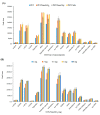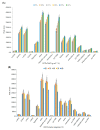Superhydrophobic Nanosilica Decorated Electrospun Polyethylene Terephthalate Nanofibers for Headspace Solid Phase Microextraction of 16 Organochlorine Pesticides in Environmental Water Samples
- PMID: 36080757
- PMCID: PMC9460059
- DOI: 10.3390/polym14173682
Superhydrophobic Nanosilica Decorated Electrospun Polyethylene Terephthalate Nanofibers for Headspace Solid Phase Microextraction of 16 Organochlorine Pesticides in Environmental Water Samples
Abstract
A new solid phase micro extraction (SPME) fiber coating composed of electrospun polyethylene terephthalate (PET) nanofibrous mat doped with superhydrophobic nanosilica (SiO2) was coated on a stainless-steel wire without the need of a binder. The coating was characterized by scanning electron microscopy (SEM) and Fourier transform infrared spectrometer (FTIR) techniques and it was used in headspace-SPME of 16 organochlorine pesticides in water samples prior to gass chromatography micro electron capture detector (GC-µECD) analysis. The effects of main factors such as adsorption composition, electrospinning flow rate, salt concentration, extraction temperature, extraction time, and desorption conditions were investigated. Under the optimum conditions, the linear dynamic range (8−1000 ng L−1, R2 > 0.9907), limits of detection (3−80 ng L−1), limits of quantification (8−200 ng L−1), intra-day and inter-day precisions (at 400 and 1000 ng L−1, 1.7−13.8%), and fiber-to-fiber reproducibility (2.4−13.4%) were evaluated. The analysis of spiked tap, sewage, industrial, and mineral water samples for the determination of the analytes resulted in satisfactory relative recoveries (78−120%).
Keywords: electrospun nanofibers; organochlorine pesticides; polyethylene terephthalate; solid-phase microextraction; superhydrophobic nanosilica.
Conflict of interest statement
The authors declare no conflict of interest.
Figures








Similar articles
-
Headspace Extraction of Chlorobenzenes from Water Using Electrospun Nanofibers Fabricated with Calix[4]arene-Doped Polyurethane-Polysulfone.Polymers (Basel). 2022 Sep 8;14(18):3760. doi: 10.3390/polym14183760. Polymers (Basel). 2022. PMID: 36145908 Free PMC article.
-
A novel graphene nanosheets coated stainless steel fiber for microwave assisted headspace solid phase microextraction of organochlorine pesticides in aqueous samples followed by gas chromatography with electron capture detection.J Chromatogr A. 2011 Sep 28;1218(39):6861-8. doi: 10.1016/j.chroma.2011.08.019. Epub 2011 Aug 16. J Chromatogr A. 2011. PMID: 21872868
-
Roles of inorganic oxide nanoparticles on extraction efficiency of electrospun polyethylene terephthalate nanocomposite as an unbreakable fiber coating.J Chromatogr A. 2015 Jan 2;1375:8-16. doi: 10.1016/j.chroma.2014.11.059. Epub 2014 Nov 28. J Chromatogr A. 2015. PMID: 25497581
-
Nano-structured polyaniline-ionic liquid composite film coated steel wire for headspace solid-phase microextraction of organochlorine pesticides in water.J Chromatogr A. 2011 Sep 16;1218(37):6285-91. doi: 10.1016/j.chroma.2011.07.041. Epub 2011 Jul 22. J Chromatogr A. 2011. PMID: 21821255
-
Novel polyamide-based nanofibers prepared by electrospinning technique for headspace solid-phase microextraction of phenol and chlorophenols from environmental samples.Anal Chim Acta. 2012 Feb 24;716:34-9. doi: 10.1016/j.aca.2011.03.016. Epub 2011 Mar 12. Anal Chim Acta. 2012. PMID: 22284875
References
-
- Lallas P.L. The Stockholm Convention on persistent organic pollutants. Am. J. Int. Law. 2001;95:692–708. doi: 10.2307/2668517. - DOI
-
- WHO (Water Health Organization) The Use of DDT in Malaria Vector Control. [(accessed on 17 July 2017)]. WHO Position Statement. Available online: http://whqlibdoc.who.int/hq/2011/WHO_HTM_GMP_2011_eng.pdf.
Grants and funding
LinkOut - more resources
Full Text Sources
Miscellaneous

